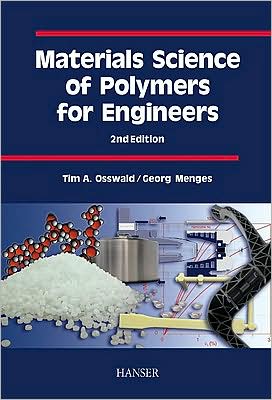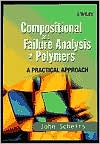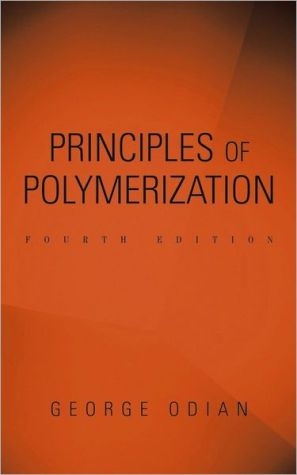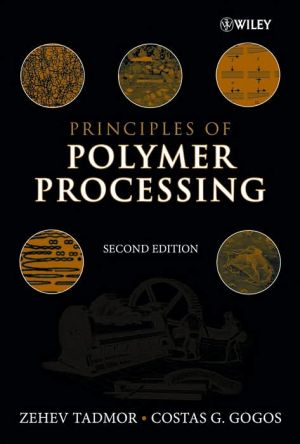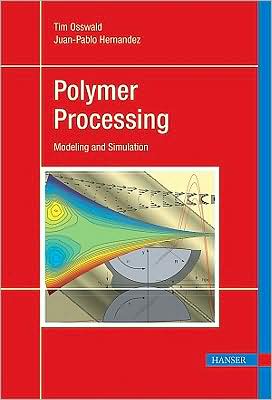Polymer Chemistry
“Highly recommended!” – CHOICE\ New Edition Offers Improved Framework for Understanding Polymers\ Written by well-established professors in the field, Polymer Chemistry, Second Edition provides a well-rounded and articulate examination of polymer properties at the molecular level. It focuses on fundamental principles based on underlying chemical structures, polymer synthesis, characterization, and properties.\ Consistent with the previous edition, the authors emphasize the logical progression...
Search in google:
“Highly recommended!” – CHOICE New Edition Offers Improved Framework for Understanding Polymers Written by well-established professors in the field, Polymer Chemistry, Second Edition provides a well-rounded and articulate examination of polymer properties at the molecular level. It focuses on fundamental principles based on underlying chemical structures, polymer synthesis, characterization, and properties. Consistent with the previous edition, the authors emphasize the logical progression of concepts, rather than presenting just a catalog of facts. The book covers topics that appear prominently in current polymer science journals. It also provides mathematical tools as needed, and fully derived problems for advanced calculations. This new edition integrates new theories and experiments made possible by advances in instrumentation. It adds new chapters on controlled polymerization and chain conformations while expanding and updating material on topics such as catalysis and synthesis, viscoelasticity, rubber elasticity, glass transition, crystallization, solution properties, thermodynamics, and light scattering. Polymer Chemistry, Second Edition offers a logical presentation of topics that can be scaled to meet the needs of introductory as well as more advanced courses in chemistry, materials science, and chemical engineering.
Introduction to Chain Molecules 1Introduction 1How Big Is Big? 3Molecular Weight 3Spatial Extent 5Linear and Branched Polymers, Homopolymers, and Copolymers 7Branched Structures 7Copolymers 9Addition, Condensation, and Natural Polymers 11Addition and Condensation Polymers 11Natural Polymers 13Polymer Nomenclature 18Structural Isomerism 20Positional Isomerism 20Stereo Isomerism 21Geometrical Isomerism 22Molecular Weights and Molecular Weight Averages 24Number-, Weight-, and z-Average Molecular Weights 25Polydispersity Index and Standard Deviation 26Examples of Distributions 28Measurement of Molecular Weight 31General Considerations 31End Group Analysis 32MALDI Mass Spectrometry 35Preview of Things to Come 37Chapter Summary 38Problems 38References 41Further Readings 41Step-Growth Polymerization 43Introduction 43Condensation Polymers: One Step at a Time 43Classes of Step-Growth Polymers 43First Look at the Distribution of Products 44A First Look at Reactivity and Reaction Rates 46Kinetics of Step-Growth Polymerization 49Catalyzed Step-Growth Reactions 50How Should Experimental Data Be Compared with Theoretical Rate Laws? 52Uncatalyzed Step-Growth Reactions 53Distribution of Molecular Sizes 55Mole Fractions of Species 56Weight Fractions of Species 58Polyesters 60Polyamides 64Stoichiometric Imbalance 67Chapter Summary 71Problems 71References 76Further Readings 76Chain-Growth Polymerization 77Introduction 77Chain-Growth and Step-Growth Polymerizations: Some Comparisons 77Initiation 79Initiation Reactions 80Fate of Free Radicals 81Kinetics of Initiation 82Photochemical Initiation 84Temperature Dependence of Initiation Rates 85Termination 86Combination and Disproportionation 86Effect of Termination on Conversion to Polymer 88Stationary-State Radical Concentration 89Propagation 90Rate Laws for Propagation 91Temperature Dependence of Propagation Rates 92Kinetic Chain Length 94Radical Lifetime 96Distribution of Molecular Weights 99Distribution of i-mers: Termination by Disproportionation 99Distribution of i-mers: Termination by Combination 102Chain Transfer 104Chain Transfer Reactions 105Evaluation of Chain Transfer Constants 106Chain Transfer to Polymer 108Suppressing Polymerization 109Chapter Summary 110Problems 110References 114Further Readings 115Controlled Polymerization 117Introduction 117Poisson Distribution for an Ideal Living Polymerization 118Kinetic Scheme 119Breadth of the Poisson Distribution 122Anionic Polymerization 126Block Copolymers, End-Functional Polymers, and Branched Polymers by Anionic Polymerization 129Block Copolymers 129End-Functional Polymers 133Regular Branched Architectures 135Cationic Polymerization 137Aspects of Cationic Polymerization 138Living Cationic Polymerization 140Controlled Radical Polymerization 142General Principles of Controlled Radical Polymerization 142Particular Realizations of Controlled Radical Polymerization 144Atom Transfer Radical Polymerization (ATRP) 144Stable Free-Radical Polymerization (SFRP) 145Reversible Addition-Fragmentation Transfer (RAFT) Polymerization 146Polymerization Equilibrium 147Ring-Opening Polymerization (ROP) 150General Aspects 150Specific Examples of Living Ring-Opening Polymerizations 152Poly(ethylene oxide) 152Polylactide 153Poly(dimethylsiloxane) 154Ring-Opening Metathesis Polymerization (ROMP) 155Dendrimers 156Chapter Summary 160Problems 161References 163Further Readings 163Copolymers, Microstructure, and Stereoregularity 165Introduction 165Copolymer Composition 166Rate Laws 166Composition versus Feedstock 168Reactivity Ratios 170Effects of r Values 171Relation of Reactivity Ratios to Chemical Structure 173Resonance and Reactivity 175A Closer Look at Microstructure 179Sequence Distributions 180Terminal and Penultimate Models 183Copolymer Composition and Microstructure: Experimental Aspects 185Evaluating Reactivity Ratios from Composition Data 185Spectroscopic Techniques 188Sequence Distribution: Experimental Determination 190Characterizing Stereoregularity 193A Statistical Description of Stereoregularity 196Assessing Stereoregularity by Nuclear Magnetic Resonance 200Ziegler-Natta Catalysts 205Single-Site Catalysts 208Chapter Summary 211Problems 212References 216Further Readings 216Polymer Conformations 217Conformations, Bond Rotation, and Polymer Size 217Average End-to-End Distance for Model Chains 219The Freely Jointed Chain 220The Freely Rotating Chain 221Hindered Rotation Chain 222Characteristic Ratio and Statistical Segment Length 223Semiflexible Chains and the Persistence Length 225Persistence Length of Flexible Chains 227Worm-Like Chains 228Radius of Gyration 230Spheres, Rods, and Coils 234Distributions for End-to-End Distance and Segment Density 235Distribution of the End-to-End Vector 236Distribution of the End-to-End Distance 239Distribution about the Center of Mass 240Self-Avoiding Chains: A First Look 241Chapter Summary 242Problems 242References 244Further Readings 245Thermodynamics of Polymer Solutions 247Review of Thermodynamic and Statistical Thermodynamic Concepts 247Regular Solution Theory 249Regular Solution Theory: Entropy of Mixing 249Regular Solution Theory: Enthalpy of Mixing 251Flory-Huggins Theory 254Flory-Huggins Theory: Entropy of Mixing by a Quick Route 255Flory-Huggins Theory: Entropy of Mixing by a Longer Route 255Flory-Huggins Theory: Enthalpy of Mixing 257Flory-Huggins Theory: Summary of Assumptions 258Osmotic Pressure 258Osmotic Pressure: General Case 259Number-Average Molecular Weight 261Osmotic Pressure: Flory-Huggins Theory 263Phase Behavior of Polymer Solutions 264Overview of the Phase Diagram 265Finding the Binodal 268Finding the Spinodal 269Finding the Critical Point 270Phase Diagram from Flory-Huggins Theory 271What's in [chi]? 275[chi] from Regular Solution Theory 275[chi] from Experiment 276Further Approaches to [chi] 278Excluded Volume and Chains in a Good Solvent 280Chapter Summary 283Problems 284References 287Further Readings 288Light Scattering by Polymer Solutions 289Introduction: Light Waves 289Basic Concepts of Scattering 291Scattering from Randomly Placed Objects 292Scattering from a Perfect Crystal 292Origins of Incoherent and Coherent Scattering 293Bragg's Law and the Scattering Vector 294Scattering by an Isolated Small Molecule 296Scattering from a Dilute Polymer Solution 298The Form Factor and the Zimm Equation 304Mathematical Expression for the Form Factor 305Form Factor for Isotropic Solutions 306Form Factor as qR[subscript g][Right Arrow]0 307Zimm Equation 307Zimm Plot 308Scattering Regimes and Particular Form Factors 312Experimental Aspects of Light Scattering 314Instrumentation 316Calibration 317Samples and Solutions 319Refractive Index Increment 319Chapter Summary 320Problems 321References 325Further Readings 325Dynamics of Dilute Polymer Solutions 327Introduction: Friction and Viscosity 327Stokes' Law and Einstein's Law 330Viscous Forces on Rigid Spheres 331Suspension of Spheres 332Intrinsic Viscosity 334General Considerations 334Mark-Houwink Equation 336Measurement of Viscosity 341Poiseuille Equation and Capillary Viscometers 341Concentric Cylinder Viscometers 345Diffusion Coefficient and Friction Factor 346Tracer Diffusion and Hydrodynamic Radius 347Mutual Diffusion and Fick's Laws 348Dynamic Light Scattering 354Hydrodynamic Interactions and Draining 357Size Exclusion Chromatography (SEC) 360Basic Separation Process 361Separation Mechanism 365Two Calibration Strategies 367Limitations of Calibration by Standards 367Universal Calibration 368Size Exclusion Chromatography Detectors 369RI Detector 369UV-Vis Detector 370Light Scattering Detector 371Viscometer 372Chapter Summary 372Problems 373References 378Further Readings 379Networks, Gels, and Rubber Elasticity 381Formation of Networks by Random Cross-Linking 381Definitions 381Gel Point 383Polymerization with Multifunctional Monomers 386Calculation of the Branching Coefficient 387Gel Point 388Molecular-Weight Averages 389Elastic Deformation 392Thermodynamics of Elasticity 394Equation of State 394Ideal Elastomers 396Some Experiments on Real Rubbers 397Statistical Mechanical Theory of Rubber Elasticity: Ideal Case 398Force to Extend a Gaussian Chain 400Network of Gaussian Strands 402Modulus of the Gaussian Network 403Further Developments in Rubber Elasticity 406Non-Gaussian Force Law 406Front Factor 407Network Defects 408Mooney-Rivlin Equation 409Swelling of Gels 410Modulus of a Swollen Rubber 411Swelling Equilibrium 412Chapter Summary 414Problems 416References 418Further Readings 418Linear Viscoelasticity 419Basic Concepts 419Stress and Strain 421Viscosity, Modulus, and Compliance 421Viscous and Elastic Responses 422Response of the Maxwell and Voigt Elements 423Transient Response: Stress Relaxation 423Transient Response: Creep 425Dynamic Response: Loss and Storage Moduli 426Dynamic Response: Complex Modulus and Complex Viscosity 429Boltzmann Superposition Principle 430Bead-Spring Model 432Ingredients of the Bead-Spring Model 432Predictions of the Bead-Spring Model 434Zimm Model for Dilute Solutions, Rouse Model for Unentangled Melts 439Phenomenology of Entanglement 444Rubbery Plateau 444Dependence of M[subscript e] on Molecular Structure 447Reptation Model 450Reptation Model: Longest Relaxation Time and Diffusivity 451Reptation Model: Viscoelastic Properties 453Reptation Model: Additional Relaxation Processes 456Aspects of Experimental Rheometry 458Shear Sandwich and Cone and Plate Rheometers 458Further Comments about Rheometry 459Chapter Summary 460Problems 461References 464Further Readings 464Glass Transition 455Introduction 455Definition of a Glass 455Glass and Melting Transitions 466Thermodynamic Aspects of the Glass Transition 468First-Order and Second-Order Phase Transitions 469Kauzmann Temperature 471Theory of Gibbs and DiMarzio 472Locating the Glass Transition Temperature 474Dilatometry 474Calorimetry 476Dynamic Mechanical Analysis 478Free Volume Description of the Glass Transition 479Temperature Dependence of the Free Volume 480Free Volume Changes Inferred from the Viscosity 481Williams-Landel-Ferry Equation 483Time-Temperature Superposition 486Factors that Affect the Glass Transition Temperature 491Dependence on Chemical Structure 491Dependence on Molecular Weight 492Dependence on Composition 492Mechanical Properties of Glassy Polymers 496Basic Concepts 496Crazing, Yielding, and the Brittle-to-Ductile Transition 498Role of Chain Stiffness and Entanglements 501Chapter Summary 504Problems 505References 508Further Readings 508Crystalline Polymers 511Introduction and Overview 511Structure and Characterization of Unit Cells 513Classes of Crystals 513X-Ray Diffraction 515Examples of Unit Cells 518Thermodynamics of Crystallization: Relation of Melting Temperature to Molecular Structure 521Structure and Melting of Lamellae 526Surface Contributions to Phase Transitions 526Dependence of T[subscript m] on Lamellar Thickness 527Dependence of T[subscript m] on Molecular Weight 530Experimental Characterization of Lamellar Structure 532Kinetics of Nucleation and Growth 536Primary Nucleation 537Crystal Growth 539Morphology of Semicrystalline Polymers 545Spherulites 545Nonspherulitic Morphologies 548Kinetics of Bulk Crystallization 551Avrami Equation 552Kinetics of Crystallization: Experimental Aspects 556Chapter Summary 561Problems 562References 565Further Readings 565Appendix 567Series Expansions 567Summation Formulae 568Transformation to Spherical Coordinates 569Some Integrals of Gaussian Functions 570Complex Numbers 572Index 575

